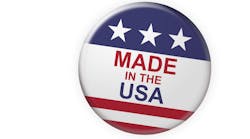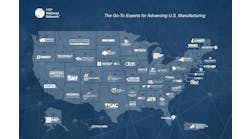In the current political climate, few issues have attracted greater attention than whether products sold in the U.S. should be manufactured here in the U.S. or imported. Related issues regarding how existing bilateral and multilateral U.S. trade arrangements and tax laws might be altered to achieve a different balance between domestic production versus imports have spawned intense lobbying efforts on both sides of the controversy. Yet, contrary to popular misconceptions, while the policy resolution of these difficult issues may have significant implications for U.S. employment, consumer prices, the strength of the dollar, foreign investments, and the like, it will have little – and often no – impact on what U.S. companies can tell their U.S. consumers about where the products they purchase are made.
The simple reason for this distinction is the long-standing policy of the Federal Trade Commission (FTC) on U.S.-origin claims – so-called “Made in USA” claims – which, as explained below, is based much more on the origin of product content than on the final location of manufacture. Moreover, although the enforcement policy has gone through some periods of relative dormancy, it is now and has for several years been the subject of active, continuing FTC enforcements.
FTC “Made in USA” Analysis
The FTC’s policy on U.S.-origin claims falls within the agency’s broad jurisdiction to regulate deceptive advertising, which applies to claims in labeling, advertisements and other promotional materials, and includes digital and other electronic formats. A claim that a product is made in the U.S. is an objective claim that must be supportable, i.e., it must be truthful and substantiated. The FTC’s policy encompasses two types of U.S.-origin claims: unqualified and qualified.
Unqualified U.S.-origin claims. In the FTC’s view, an unqualified claim of U.S. origin (e.g., “Made in USA,” “Produced in USA,” “Manufactured in USA”) means that “all or virtually all” of the product has been made in the U.S. The product must have no more than a negligible amount of foreign content. To meet this requirement, the marketer must satisfy three criteria: (1) the last significant manufacturing or processing must have been done in the U.S. (i.e., the product must have been last “substantially transformed” in the U.S., which means that the article that emerges from the manufacturing process in the U.S. has a name, character or use that differs from the original material subjected to the process); (2) the product must have a very high proportion of U.S. versus foreign content; and (3) the article must not have foreign components that consumers reasonably would view as significant to the final product. Thus, the extent of foreign content, even if relatively minor, must be measured along with its importance in the final product. For example, the FTC has held that a product made in the U.S. with parts that comprised 18% of the total cost of the final product could not be labeled with an unqualified U.S.-origin claim.
Qualified U.S.-origin claims. Qualified U.S.-origin claims allow companies substantial flexibility. The marketer may state that its product is made in the U.S. with imported parts, without specifying the source country, the specific parts, or percentage of foreign parts, as long as the U.S. content or processing is significant. The manufacturer also may identify particular foreign content (e.g., Brazilian teak wood), if the manufacturer considers it a desirable marketing feature. Percentage-content claims (e.g., “60% U.S. content”) are also allowed as long as the calculation of cost percentages follows a generally accepted methodology. (In this context, “costs” refers to the total cost of all manufacturing materials, direct manufacturing labor, and manufacturing overhead.)
If the qualified U.S.-origin claim denotes or implies manufacture in the U.S., however, the FTC will require that the product have been last substantially transformed in the U.S. Therefore, labels such as “Made in USA with foreign parts,” “Produced in USA with imported raw materials,” or “Manufactured in USA with sub-assemblies from Japan,” would be allowable only if the product underwent its final “substantial transformation” here in the U.S. (This is the same test applied by U.S. Customs in its foreign country-of-origin determinations.)
“Assembled in USA” is a common but distinct form of qualified U.S.-origin claim. Unlike other qualified U.S.-origin claims, however, an “Assembled in USA” claim permits the marketer to link its product with the U.S. without referring to any foreign content, even when the product components may be sourced from abroad. This claim, however, requires that the product have undergone its last substantial transformation in the U.S. and its principal assembly here. Thus, a “screwdriver” operation assembling imported parts into a final product in the U.S. will not qualify for “Assembled in USA” treatment. Further, even when such a claim may be permissible, companies may not consider it an attractive marketing proposition. Rather, because the “Assembled in USA” label makes no reference to any U.S. content, companies whose products contain substantial domestic content may well prefer to use a qualified U.S.-origin claim that cites the presence of domestic content, as described above.
Recent FTC Enforcement Activity
The FTC’s recent proposed consent orders involving Block Division and iSpring are illustrative of the commission’s enforcement of unsupported U.S.-origin claims. In early March 2017, the commission entered a settlement agreement with Block Division, Inc. regarding advertising and promotional claims the company had made with respect to its pulley block systems. Specifically, the FTC’s complaint alleged that Block Division had depicted its products with unqualified “Made in USA” representations when significant portions of the products consisted of foreign parts, including imported steel plates which already had been stamped “Made in USA” when they entered the U.S. In February 2017, the FTC entered a settlement agreement with iSpring to resolve allegations that iSpring had sold various water filtration systems online and through major independent retailers by advertising its products as “Built in USA” and “Proudly Built in USA” when, according to the FTC’s complaint, many of the company’s products were either made entirely overseas or contained significant foreign content.
The proposed orders in both of these matters prohibit the companies from asserting any unqualified U.S.-origin claims unless they can demonstrate that all significant processing, including final assembly or processing, occurred in the U.S. and that all or virtually all ingredients are made and sourced in the U.S. The orders require the companies to create certain records, including accounting, personnel, consumer complaint and other documentation relating to the order, over a 20-year period.
An example of an FTC consent agreement that included a financial remedy is the commission’s October 2016 settlement with Chemence Inc. The FTC’s complaint against the company alleged that although Chemence advertised its glue products as “Made in USA,” 55% of the cost of the chemical components derived from imports. The FTC also alleged that the company furthered this deceptive effort by distributing marketing materials to private label and other sellers that contained the misleading U.S.-origin representations. The terms of the consent order are essentially the same as in the iSpring and Block Division orders, but also included a $220,000 settlement amount as equitable relief.
In addition to its various enforcement actions resulting in complaints and consent orders, the FTC has resolved a significant number of “Made in USA” investigations through closing letters in which the agency has accepted companies’ corrective action plans. In 2015-2017, the FTC issued many such closing letters to companies across a broad range of product industries, including computers, watches, leather goods, bicycles, lanyards, cookware, medical and dental products, clothing and accessories, pottery, furniture, pillows, motors, and eyeglass accessories, among other products.
California U.S.-Origin Requirements
Unlike the FTC’s Made in USA enforcement policy, California’s revised U.S.-origin statute, which took effect January 1, 2016, establishes specific criteria as safe harbors. The California statute prohibits unqualified U.S.-origin representations if the “article, unit, or part thereof, has been entirely or substantially made, manufactured, or produced outside of the United States.” The prohibition, however, excludes merchandise if it meets either of two criteria: (1) the total foreign content does not exceed 5% of the final wholesale value of the merchandise; or (2) the seller can establish that it could not produce or source the article, unit, or part in the U.S., and the total foreign content does not exceed 10% of the final wholesale value of the merchandise.
Conclusion
Commenting on the ongoing debate over imports versus domestic U.S. production, an international trade official recently opined that more U.S. companies should be able to “stamp” their products “Made in America.” Marketing executives, however, need to disregard such simplistic – and potentially misguided – speculation and understand that, whatever other implications resolution of the trade debate may have, the ability to advertise products as “Made in USA” will rest on variables other than solely the location of final manufacture.
Paul Laurenza is the Office Managing Member of Dykema's Washington, D.C. office. He represents consumer product, automotive and other clients on federal regulatory and related litigation issues, including those before the U.S. Consumer Product Safety Commission, Department of Transportation, Federal Trade Commission and U.S. Customs and Border Protection.




